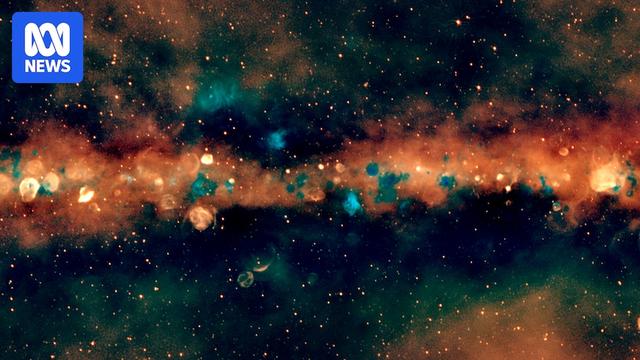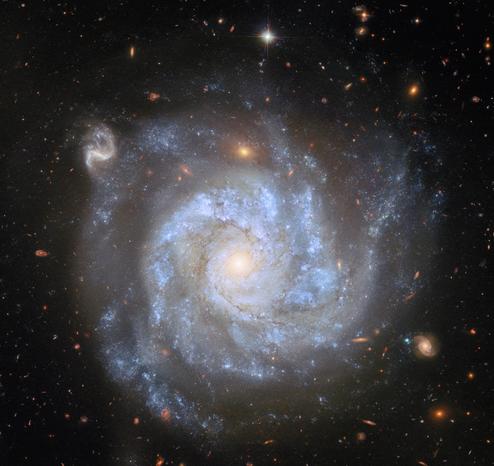in the #arXiv
Dissecting the Perseus-Pisces supercluster observed with CFHT-MegaCam: Investigating environmental effects on galaxy morphology
by Maëlie Mondelin and co-authors
https://arxiv.org/abs/2511.05925
in the #arXiv
Dissecting the Perseus-Pisces supercluster observed with CFHT-MegaCam: Investigating environmental effects on galaxy morphology
by Maëlie Mondelin and co-authors
https://arxiv.org/abs/2511.05925
New 'radio map' of Milky Way reveals where stars are born and die
By Chris Lewis
The Milky Way appears as a dusty band of stars, but by observing its radio frequencies a different view can bee seen, revealing parts of the galaxy hidden from sight.
https://www.abc.net.au/news/2025-11-11/milky-way-radio-map-shows-where-stars-live-and-die/105976276

More to fathom as I remain on my travels — this time from the ‘eye’ of the #JWST
Cosmography archives
The Distribution of Extra-Galactic Nebulae
by Edwin Hubble (1934)
https://ui.adsabs.harvard.edu/abs/1934ApJ....79....8H/abstract
Quentin Pilate s'est intéressé aux mécanismes responsables de la perte de #masse d'#étoiles de type super-géante rouge telles Bételgeuse et Antarès : https://www.irap.omp.eu/event/imagerie-de-la-photosphere-des-super-geantes-rouges-lorigine-de-la-perte-de-masse/
... tandis que Mathilde Bouvier, postdoc à @universiteitleiden , présentera un séminaire sur la complexité chimique des #galaxies proches : https://www.irap.omp.eu/event/chemical-complexity-in-nearby-galaxies-the-case-of-ngc-253-2/
The second image is released today by #ESA and the EC, a near-infrared view by #Euclid's NISP instrument of the 'Dark Cloud' LDN 1641:
https://www.esa.int/ESA_Multimedia/Images/2025/11/Euclid_peers_through_a_dark_cloud_s_dusty_veil

We also created an interactive version with zooms into each galaxy on our blog:
We are releasing seven new scientific publications today, based on our Q1 data release earlier this year. All revolve around various aspects of galaxy evolution. They are accompanied by two new image collages:
The first one is a #Euclid-based re-creation of the classical 'morphology tuning fork' of galaxy shapes – the second a near-infrared view into the 'dark cloud' LDN 1641, released by #ESA.
Read more in our press release:
https://www.euclid-ec.org/public/press-releases/new-science-results-images-euclid-q1/
WRITER FUEL: 'Staggering' first images from Vera C. Rubin Observatory show 10 million galaxies — and billions more are on the way.
Cosmography archives
Large-scale superclusters surrounding the giant galaxy void in Boötes?
by Neta Bahcall and Raymond Soneira (1982)
https://ui.adsabs.harvard.edu/abs/1982ApJ...258L..17B/abstract
https://www.earth.com/image/ngc-1309-the-star-that-survived-its-own-explosion/
Today’s Image of the Day from the European Space Agency features a stunning view of the spiral galaxy NGC 1309 captured by the Hubble Space Telescope... #Esa #photography #stars #hubbletelescope #galaxies

The bold idea that spacetime doesn’t exist https://www.byteseu.com/1506638/ #Galaxies;Astrophysics;ExtrasolarPlanets;Sun;TravelAndRecreation;OceanPolicy;PopularCulture;Ethics #Science
Going to do a comparison between the s50 and Odyssey Pro once here are #M65 / #M66 / #NGC3628 #Galaxies - aka #TheLeoTriplet. First and third images are from the s50, while the second and forth are from the Odyssey Pro. #unistellar #odysseypro #space #astronomy #amateur #seestar #S50
Incredible! Dark Galaxy Right Next to Us Could Be a Little Red Dot (Segue 1) - YouTube
https://www.youtube.com/watch?v=V21YRa5Sy9M
New image captures spooky bat signal in the sky
Press Release 31 October 2025 A spooky bat has been spotted flying over the European Southern Observatory’s (ESO’s)…
#NewsBeep #News #Space #ALMA #Astronomie #Astronomy #Astrophysics #AU #Australia #Chile #comets #detectors #ELT #ESO #eso.org #galaxies #Garching #LaSilla #Nebulae #NTT #Paranal #Planets #Science #stars #Suedsternwarte #Telescopes #Universe #VLT #VLTI
https://www.newsbeep.com/au/252913/
Galaxies, runner-up: Cosmic Coincidences by Deep Sky Collective
The Deer Lick region, home to NGC 7331 and the famous Stephan’s Quintet, makes for a stunning display of galactic interaction. Over six months, 12 photographers and a dedicated processing team worked to integrate nearly 600 hours of exposure to reveal these faint details at the Dark Sky New Mexico observatory in the US
Rubin Observatory and the Galaxies
Starting in late 2025, when it begins the decade-long Legacy Survey of Space and Time (LSST), Rubin will capture skies like these in more detail than ever before.
Credit: @VRubinObs / P.J. Assuncao Lago
in the #arXiv
Faint galaxies in the Zone of Avoidance revealed by JWST/NIRCam
by José Luis Nilo Castellón and co-authors
https://arxiv.org/abs/2510.12488
NOIRLab image of the week
A Cluster of Interacting Galaxies (Abell 3754)
Credit: Dark Energy Survey/DOE/FNAL/DECam/CTIO/NOIRLab/NSF/AURA; Image processing: R. Colombari, M. Zamani (NSF NOIRLab) & T.A. Rector (University of Alaska Anchorage/NSF NOIRLab)